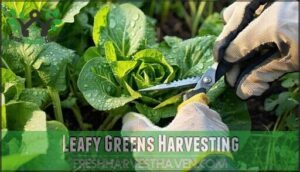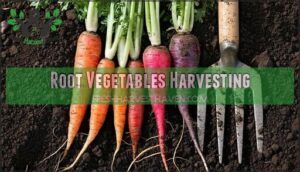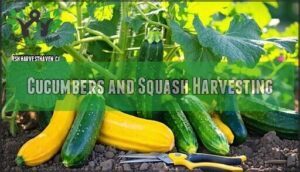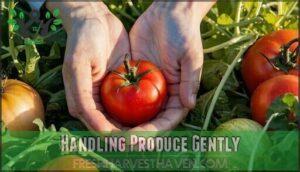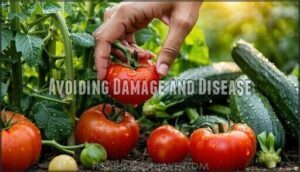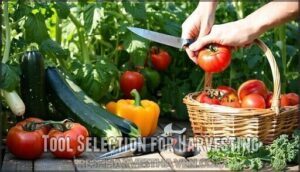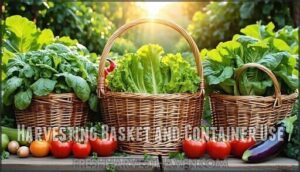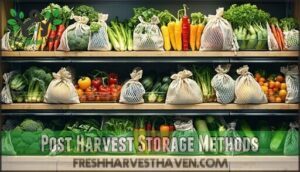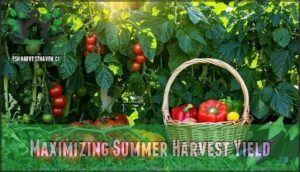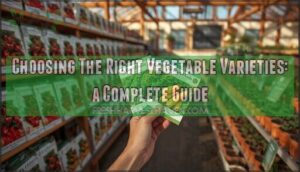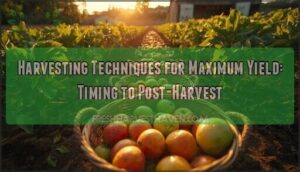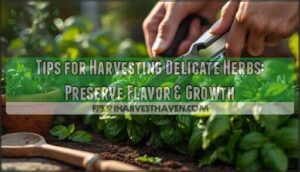This site is supported by our readers. We may earn a commission, at no cost to you, if you purchase through links.
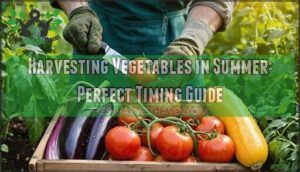 Harvesting vegetables in summer requires perfect timing to capture peak flavors and nutrition.
Harvesting vegetables in summer requires perfect timing to capture peak flavors and nutrition.
You’ll want to check your garden daily during early morning hours when temperatures are cooler and plants are fully hydrated. Look for visual cues like deep color saturation in tomatoes, firm snap in green beans, and appropriate size in zucchini before they become baseball bats overnight.
Most summer vegetables taste best when harvested slightly underripe rather than overripe, since they’ll continue developing sugars after picking.
Use clean, sharp tools to avoid damaging plants and spreading disease. The secret lies in reading your plants’ subtle signals rather than relying solely on calendar dates.
Table Of Contents
- Key Takeaways
- Summer Harvest Timing
- Vegetable Readiness Checks
- Harvesting Techniques Tips
- Post Harvest Storage Methods
- Maximizing Summer Harvest Yield
- Frequently Asked Questions (FAQs)
- What do you harvest in summer?
- Does it matter what time of day you harvest vegetables?
- How hot is too hot for a vegetable garden?
- What is the quickest vegetable to harvest?
- When to harvest summer vegetables?
- How do I know when my vegetables are ready to pick?
- Should you water vegetables every day in summer?
- How do you store vegetables in the summer?
- Do you harvest in the summer?
- How do companion plants affect vegetable harvesting?
- Conclusion
Key Takeaways
- Check your garden daily in the early morning – You’ll catch vegetables at peak ripeness and avoid the stress of midday heat, which preserves flavor and extends shelf life.
- Look for visual cues rather than calendar dates – You’ll get better results by watching for deep colors, firm textures, and appropriate sizing instead of following rigid harvest schedules.
- Harvest slightly underripe vegetables – You’ll capture peak flavors since most summer vegetables continue developing sugars after picking, giving you better taste than overripe produce.
- Use clean, sharp tools and gentle handling – You’ll prevent plant damage and disease spread while maintaining produce quality for longer storage and better garden-to-table freshness.
Summer Harvest Timing
Summer’s peak harvest season demands perfect timing to capture your vegetables at their nutritional and flavor best.
You’ll want to check your garden daily during these critical weeks, as vegetables can go from perfectly ripe to overripe in just 24 hours.
Peak Ripeness Indicators
Recognizing peak ripeness in your summer vegetable harvest requires mastering visual cues, texture analysis, and aroma indicators.
Sugar content peaks when colors deepen and size matters for ideal flavor.
Garden fresh vegetables reveal their readiness through firm textures and sweet scents.
Your summer garden bounty offers clear signals when picking ripe vegetables becomes second nature through careful observation, allowing you to identify complete concepts and understand the importance of summer vegetable harvest.
Daily Garden Checks
Through daily checks, you’ll catch your summer vegetable harvest at peak perfection and spot problems before they spiral.
Think of yourself as a garden detective, making quick rounds to assess your summer garden bounty.
- Pest Patrol: Scan leaves for unwanted visitors lurking beneath
- Plant Health: Check for yellowing, wilting, or disease spots
- Soil Moisture: Test dirt with your finger for watering needs
- Weed Control: Pull small invaders before they establish roots
- Ripeness Assessment: Evaluate picking ripe vegetables daily for maximum flavor
Morning Harvest Benefits
Harvesting summer crops during cooler temperatures creates the perfect recipe for success.
Morning’s gentle embrace preserves your homegrown summer produce at peak quality, reducing stress on both plants and harvester.
One key is to verify peak ripeness for the best results.
| Benefit | Morning Advantage | Result |
|---|---|---|
| Cooler Temperatures | Plants haven’t heated up yet | Reduced stress on vegetables |
| Enhanced Flavor | Sugar content peaks overnight | Better-tasting summer vegetable varieties |
| Increased Nutrients | Vitamins remain concentrated | Healthier organic vegetable gardening yields |
| Extended Shelf-Life | Less field heat to remove | Seasonal vegetable harvest lasts longer |
Vegetable Readiness Checks
Knowing when your vegetables are ready for harvest can mean the difference between crisp, flavorful produce and bitter disappointment.
Each vegetable type has specific indicators that signal peak readiness, from the deep green color of mature spinach leaves to the firm shoulders of carrots peeking through the soil, which are complete concepts that help determine the best time to harvest.
Leafy Greens Harvesting
Your leafy greens are ready when leaves reach full size but remain tender.
Fresh greens reveal their readiness through size and tenderness—harvest when leaves are full but still soft.
Harvest in early morning when temperatures are cool and plants are well-hydrated. Use sharp, clean scissors or knives for cutting methods that won’t damage stems.
Cut outer leaves first, allowing centers to continue growing for multiple harvests throughout summer. This harvesting frequency maximizes your homegrown summer produce yield from organic vegetable gardening efforts.
Root Vegetables Harvesting
Beneath the soil surface, your best summer vegetables send clear maturity signs when they’re ready for harvest.
Check for crown shoulders poking above ground—carrots at ¾-inch diameter, beets at 2-3 inches. Loose soil type makes extraction easier, so water the night before harvesting.
Use proper harvesting tools like a garden fork to avoid damage. These summer harvest tips guarantee your healthy summer eating goals stay on track.
For easier harvesting, consider loosening the soil beforehand to ensure a successful and stress-free harvest.
Brassicas Harvesting
Brassicas thrive in cool weather, making timing critical for harvesting cabbage, harvesting broccoli, and harvesting cauliflower during summer heat.
These best summer vegetables require daily monitoring for pest control and bolting prevention. One key factor is to avoid temperature fluctuations that can cause bolting.
- Broccoli: Harvest when heads are compact and tight (50-90 days)
- Cabbage: Pick softball-sized, firm heads before splitting occurs
- Cauliflower: Cut when curds remain white and unseparated
Morning harvests improve shelf life for summer harvest tips and summer garden maintenance success.
Cucumbers and Squash Harvesting
Summer squash should be picked when they’re still tender and about 6-8 inches long. Check cucumber ripeness daily—they grow fast.
Use sharp harvesting tools to avoid damaging vines. Pest impact can reduce storage life, so inspect carefully.
Fresh picks work perfectly in summer vegetable recipes and fresh summer salads. Keep up with vegetable garden planning for continuous harvests throughout your summer garden maintenance routine.
Harvesting Techniques Tips
Once you’ve identified which vegetables are ready, proper harvesting technique makes the difference between bruised produce and perfect crops.
The right tools and gentle handling will keep your summer vegetables fresh longer and prevent disease from spreading through your garden, which is crucial for maintaining healthy crops.
Handling Produce Gently
Once you’ve determined your vegetables are ready to pick, treat them like precious gems.
Handle your harvest like treasured heirlooms—gentle care preserves peak flavor and extends garden-to-table freshness.
Your hands are the first tool in preserving summer vegetables—work gently to avoid bruising.
- Cradle each tomato like you’re holding a newborn’s head
- Support heavy squash from underneath to prevent stem damage
- Twist, don’t yank when harvesting to keep plants productive
Gentle washing immediately after harvest removes field dirt without shocking delicate skins.
Careful sorting separates perfect specimens from those needing immediate use.
Proper packing in shallow containers prevents crushing, while avoiding overfilling maintains air circulation for your summer vegetable recipes and fresh summer salads.
Avoiding Damage and Disease
When you handle your harvest with care, you’re also protecting your crop from pests and diseases that can ruin your hard work.
Clean hands and sanitized tools prevent spreading harmful bacteria between plants.
Avoid harvesting wet vegetables since moisture promotes fungal growth.
One key is to use gentle handling methods to avoid bruising.
| Prevention Strategy | Disease Risk | Impact on Harvest |
|---|---|---|
| Harvest during dry conditions | Fungal infections spread rapidly | Entire crop loss possible |
| Clean tools between plants | Bacterial contamination transfer | Spoiled summer vegetables |
| Remove damaged produce immediately | Attracts pests, spreads disease | Reduced storage life |
| Practice proper watering practices | Root rot, leaf diseases | Poor soil health affects yield |
| Provide sunburn protection for sensitive crops | Weakened plant immunity | Lower quality summer garden to table experience |
Disease prevention starts in your garden through pest control and continues through harvest.
Damaged vegetables attract insects and spread problems to healthy produce, affecting your summer vegetable dishes and summer cooking ideas.
Tool Selection for Harvesting
Right tools make the difference between bruised tomatoes and perfect summer garden to table meals.
Sharp knife vs. scissors depends on your crop—knives work best for thick-stemmed vegetables, while scissors excel with delicate herbs.
Ergonomic considerations matter during long harvest sessions; lightweight tools with comfortable grips prevent hand fatigue.
Cleaning practices between plants stop disease spread, keeping your political landscape of garden plots healthy.
Specialized tools like pruning shears handle woody stems efficiently.
Regular tool maintenance guarantees clean cuts for your summer cooking ideas.
To find the right equipment, explore a range of specialized vegetable tools.
Harvesting Basket and Container Use
Choose breathable basket materials like wicker or mesh for maximum airflow.
Select container sizes that prevent overcrowding—you’ll avoid bruised produce and maintain quality during transport.
Guarantee proper drainage needs by using perforated containers, especially for freshly washed vegetables.
When transporting produce from garden to kitchen, sturdy handles make the journey smooth.
Consider a dedicated vegetable collecting container for efficient harvesting.
Clean baskets thoroughly between harvests to prevent contamination and extend their lifespan for seasons ahead, ensuring a longer lifespan.
Post Harvest Storage Methods
Once you’ve harvested your summer vegetables, proper storage becomes essential to maintaining their freshness and nutritional value.
You’ll need to act quickly to cool your produce and select the right storage methods to prevent spoilage and extend shelf life.
Cooling and Refrigeration
Once you’ve harvested your vegetables properly, immediate cooling becomes your next priority.
Temperature control makes the difference between crisp lettuce and wilted disappointment within hours.
- Set refrigerator to ideal temperature of 32-40°F for most vegetables
- Monitor humidity levels at 85-95% to prevent moisture loss
- Use energy-efficient cooling methods like pre-cooling in cold water
- Implement proper cooling techniques to extend storage duration substantially
- Consider root cellars or cool basements as natural alternatives
Storage Container Selection
After proper cooling, container material becomes your next defense against spoilage.
Glass jars and BPA-free plastic containers work best for most vegetables.
Size matters—choose containers that fit your harvest without cramming.
Airtight options prevent moisture loss and contamination, ensuring food safety.
Like Texas Democrats fleeing redistricting battles, your produce needs secure refuge.
Many rely on specialized vegetable jars for ideal preservation.
Consider cost analysis when selecting reusable containers versus disposable options for long-term savings.
Humidity Control and Monitoring
Your storage containers are sorted, but keeping your harvest fresh requires mastering humidity sensors and ideal levels.
Install digital hygrometers in storage areas to maintain 90-95% humidity for leafy greens and root vegetables.
Greenhouse ventilation systems with air circulation prevent mold growth while sustaining moisture.
Monitor readings daily—like gerrymandering districts, proper boundaries matter for success.
Spoilage Prevention and Detection
While some produce requires vigilant monitoring, catching spoilage early saves your entire harvest from disaster.
Quick daily checks help you spot trouble before it spreads like wildfire through your storage containers.
- Early Detection: Check for soft spots, discoloration, or unusual odors daily
- Spoilage Indicators: Remove any vegetables showing wrinkled skin or dark patches immediately
- Storage Techniques: Separate damaged produce to prevent contamination spread
To maximize longevity, consider root cellar conditions for certain vegetables.
These Handling Methods will Extend Shelf-life substantially.
Maximizing Summer Harvest Yield
Getting the biggest harvest from your summer garden isn’t just about picking what’s ripe—it’s about setting yourself up for success from day one.
Smart planning, proper soil care, and strategic watering can double or triple your yields compared to a haphazard approach.
Crop Rotation and Planning
Once you’ve got your storage systems dialed in, smart crop rotation becomes your secret weapon for bigger yields next season.
You can’t just throw seeds around like confetti—planning prevents poor performance.
Here’s your rotation game plan:
| Crop Family | Follow With |
|---|---|
| Legumes (beans, peas) | Heavy feeders (tomatoes, corn) |
| Heavy feeders | Light feeders (herbs, onions) |
| Root crops (carrots, beets) | Leafy greens (lettuce, spinach) |
| Brassicas (cabbage, broccoli) | Legumes or cover crops |
| Nightshades (tomatoes, peppers) | Root vegetables |
Rotation benefits include healthier soil, better pest control, and improved nutrient cycling.
Planning software helps track what goes where, making your garden more productive than Texas Democrats redistricting voter rights—strategic moves that pay off long-term for Republicans and gardeners alike.
Companion Planting Strategies
Team up your vegetables to maximize summer harvests through strategic companion planting.
You’ll boost yields while creating natural defenses against common garden problems.
Strategic companion combinations deliver multiple benefits:
- Pest Control – Marigolds and nasturtiums repel squash bugs and cucumber beetles
- Growth Support – Beans fix nitrogen for neighboring heavy feeders like tomatoes
- Space Optimization – Tall corn supports climbing beans while ground-level squash spreads below
This Nutrient Sharing approach mirrors nature’s blueprint.
Pollinator Attraction through diverse plantings guarantees better fruit set across your entire garden.
Soil Preparation and Maintenance
Healthy soil forms the foundation for bountiful harvests.
While companion plants work together above ground, what happens below matters just as much.
Regular soil testing reveals nutrient balance needs, guiding your composting methods and amendments.
| Soil Task | Summer Focus |
|---|---|
| Soil Testing | Check pH and nutrients monthly |
| Nutrient Balance | Add compost between plantings |
| Weed Control | Hand-pull when soil is moist |
| Mulch Application | Maintain 2-3 inch layer around plants |
Irrigation Management and Scheduling
Watering your garden isn’t rocket science, but timing matters more than you’d think.
Check soil moisture daily—stick your finger two inches deep into the earth.
Water early morning when temperatures are cooler and evaporation rates drop.
Deep, infrequent watering beats frequent shallow drinks every time.
Focus on root zones rather than leaves to prevent disease and maximize water efficiency for healthier harvests.
Frequently Asked Questions (FAQs)
What do you harvest in summer?
You’ll harvest tomatoes, peppers, cucumbers, zucchini, corn, beans, eggplant, and herbs like basil. Summer’s bounty includes berries, melons, and leafy greens that thrive in warm weather conditions.
Does it matter what time of day you harvest vegetables?
Sure, timing doesn’t really matter – but you’re wrong.
Early morning harvests deliver crispier vegetables with higher water content.
You’ll get better flavor and longer storage life when you pick before the day’s heat kicks in, which results in better flavor.
How hot is too hot for a vegetable garden?
When temperatures consistently exceed 90°F, most vegetables start struggling.
You’ll notice wilting, stunted growth, and poor fruit set.
Tomatoes, peppers, and beans handle heat better than lettuce and spinach, which bolt quickly in extreme temperatures.
What is the quickest vegetable to harvest?
Lightning-fast radishes’ll have you harvesting in just three weeks.
You can’t beat radishes for speed—they’re ready to pull from soil in 20-25 days.
Plant them every two weeks for continuous harvests throughout your growing season.
When to harvest summer vegetables?
You’ll know it’s time when vegetables reach peak color, size, and firmness.
Check daily during growing season – tomatoes should yield slightly, peppers feel crisp, and beans snap cleanly when bent.
How do I know when my vegetables are ready to pick?
Amazingly, 90% of home gardeners harvest too early or too late.
You’ll know your vegetables are ready when they show their telltale signs: tomatoes give slightly to gentle pressure, peppers develop glossy skin, and zucchini reaches 6-8 inches long.
Should you water vegetables every day in summer?
You shouldn’t water vegetables daily in summer. Instead, check soil moisture by sticking your finger two inches deep. Water deeply when the top inch feels dry, typically every 2-3 days.
How do you store vegetables in the summer?
A penny saved is a penny earned, so store your summer vegetables properly to maximize freshness.
Keep tomatoes at room temperature, refrigerate leafy greens in perforated bags, and store potatoes in cool, dark places away from onions to properly maintain their quality.
Do you harvest in the summer?
Yes, you’ll harvest plenty during summer! Peak season brings tomatoes, peppers, zucchini, beans, and herbs. You’ll be picking almost daily once things get going—it’s the garden’s most productive time.
How do companion plants affect vegetable harvesting?
Tomato plants paired with basil repel harmful pests naturally, making your harvest cleaner and more abundant.
You’ll find companion plants boost yields, improve flavor, and reduce pest damage, creating a thriving garden ecosystem that works smarter, not harder.
Conclusion
Time flies when you’re harvesting vegetables in summer, but rushing the process leads to disappointment.
Master the art of reading your plants’ signals, check daily for ripeness indicators, and harvest during cool morning hours.
Use proper techniques and tools to maintain quality while preventing damage.
Store your bounty correctly to extend freshness and maximize nutritional value.
With consistent observation and gentle handling, you’ll enjoy peak-flavor vegetables throughout the season.
- https://yardandgarden.extension.iastate.edu/how-to/vegetable-harvest-guide
- https://carpathen.com/blogs/news/summer-garden-plants-best-vegetables-and-crops-for-a-thriving-harvest
- https://ncfreshproducesafety.ces.ncsu.edu/postharvest-produce-guide/produce-guide-leafy-greens/
- https://nevegetable.org/cultural-practices/estimating-vegetable-yields
- https://www.geturbanleaf.com/blogs/care/how-to-care-for-your-summer-harvest

